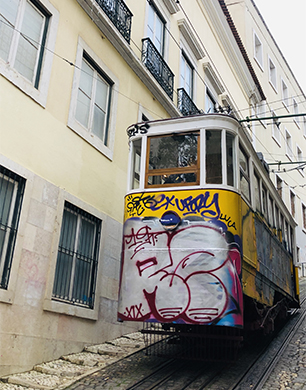 Whatever anyone tells you about Lisbon, take comfy shoes!
Whatever anyone tells you about Lisbon, take comfy shoes!
It might be uber trendy, with countless rooftop bars, contemporary art and inventive restaurants, it is also renowned for its seven hills- offering panoramic views over the Pantheon and River Tagus; and as everyone knows, the best way to get around a new city is exploring by foot- sensible shoes and tote bag for shopping, are a must!
It’s a city with a beach, so there is something to do whatever season you visit – with architectural aficionados, history buffs, and glass, crystal, porcelain and pottery will appreciate the traditional the mosaics which depict Lisbon and are still peppered on the facades. Foodies will also be extremely well catered for, and any trip should begin with Lisbon’s famous pasteis de nata.
Whether you are a first time visitor, or have been to Lisbon before, the contrast of old and new is spectacular. With the imposing São Jorge Castle with its Baroque design and dramatic carved spires dominating the skyline, the Old Town and its warren of winding streets and alleys are remnants of its chequered history, which has seen Christian crusaders, Berbers and Arabs ruling the port town. To this day, you can see shop fronts where families have been salting cod and preparing piri-piri chicken for generations.
The city is accessible by foot, but be warned, the hills are steep. Tourists love the wooden trams that rattle around the city, and are very easy to navigate. Jump on the number 28 tram and climb up to Alfama which used to have a grim reputation (due to association with Moorish pirates), but it is now transformed into a fashionable, artisan district. A maze of narrow cobbled streets, alleyways, vertiginous steps and traditional Portugese houses, it is worth exploring and offers an exceptional cityscape from the summit.
Dominated by a Moorish castle (which offers a stunning sunset), it has bustling squares and a friendly vibe. Some of the cities major landmarks including the Tejo Estuary, Se Cathedral, Castelo de São Jorge, Panteão Nacional and the Igreja de Santo António, are located within this historical quarter; and if you coincide your visit with a Tuesday or Saturday, the flea market at Feira da Ladra should not be missed. Founded in the 12th century, it was a trading ground for gypsies and the name translates to ‘Market of the Female Thieves’; however, it is now perfectly safe, and great for rummaging through piles of bric-a-brac. Haggling essential!
The massive ‘Urban Mural’ by André Saraiva is also worth checking out. Taking over the walls at the start of the market, it consists of 52,000 small azulejo tiles. This eccentric kaleidoscope of colour is Lisbon’s largest public artwork but to see the mural in all its glory- avoid visiting when the flea market is in progress.
Acclaimed gallery Underdogs was founded by one of Lisbon’s best known street artists, VHILIS, aka Alexandre Manuel Dias Farto, who uses a unique method of drilling and carving to make his mark. His constantly evolving showroom houses limited edition art, signed paintwork and books, from a host of artists from around the globe.
Visitors will never get round to experiencing all of Lisbon’s art offerings in one weekend. It truly is a city of culture. The Mude is Lisbon’s Museum of Fashion and Design and although shut for refurbishment at the moment, is worth checking out for frequently changing exhibitions and talks for fashion fans. Whereas the Maat The Museum of Art, Architecture and Technology (MAAT) is a modern icon. Converted from a former power station, the ambitious design is linked to a modern apex designed by British architect Amanda Levete, and is completed with an unconventional pedestrian roof offering astounding views across the city. Standing proudly on the River Tagus, it fuses the city’s cultural heritage with a futuristic vibe.
With plenty of options for any budget, socialising is a big part of Portuguese life. Bairro Alto is probably one of the most well known, and tourist districts of Lisbon, and should be avoided during the day if you don’t like crowds (or street entertainers). However the nightlife is buzzing and the weekends bring locals and visitors to the countless bars, clubs and tattoo parlours. For the more discerning guest, there are plentiful rooftop bars and underground clubs if you want to avoid the crowds.
If you wish to explore further afield, and get to know where the locals hang out, there are several lively towns and cities closeby, including Nantes, a thriving cultural hub to the west, the ancient cathedral town of Tours, and Angers which has some great nightlife. The best beaches can be found in the city’s suburbs and are connected by the promenade. Adraga, Guincho and Grande are the most well known and are found on the coastal road north, beyond Cascais- however, you can get there by train, which takes about 40 minutes. On the other hand, if fairytale palaces, botanical gardens and wild woodlands, are more your thing, spend a day in Sintra. Well worth a day trip – just try and stop yourself booking a ticket back!
Stay at the five star Tivoli Avenida Liberdade for a touch of class for the duration of your vacation. Centrally located so you can walk everywhere and enjoy the sights. But with a choice of restaurants, bars, pool and spa on site, you might want to stay put and celeb spot. Get a seat at the Sky Bar which offers breathtaking views of St George’s Castle and the Arrábida Mountains, and enjoy people watching with incredible cocktails and delicious sushi.
FACTBOX:
- Nightly rates at Tivoli Avenida Liberdade start from £189 based on two people sharing on a B&B basis
- TAP Air Portugal has a daily departure from London Heathrow, London Gatwick & Manchester to Lisbon. For further information visit flytap.com or call 0345 601 0932.

